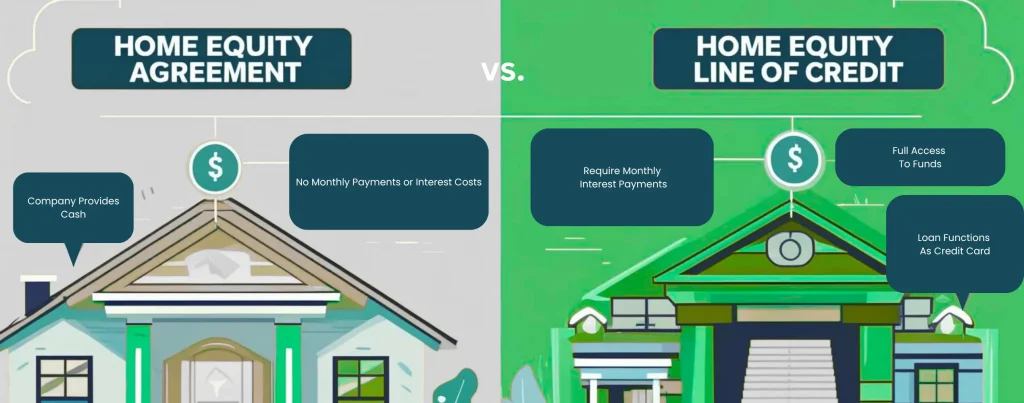Home Equity Agreements vs. HELOC?

Home Equity Agreements vs. HELOC?
When it comes to accessing your home’s equity, you might be considering a Home Equity Agreement (HEA) or a Home Equity Line of Credit (HELOC). While they sound similar, these financial tools are fundamentally different. In this post, Sam Kwak, co-founder of Accelerated Strategies and a real estate investor with nearly a decade of experience, breaks down how each works, their key differences, and which might suit your needs.
What Is a Home Equity Agreement (HEA)?
An HEA is not a loan but an agreement with a real estate investment company. Here’s how it works:
– The company provides you with cash (e.g., $50,000) in exchange for a percentage of your home’s value (typically 5-15%, say 10% for a $500,000 home).
– The company becomes a co-owner of your home, sharing in its future appreciation.
– There are no monthly payments or interest costs.
– When you sell or refinance, the HEA company gets their initial investment back ($50,000) plus a share of the home’s appreciation (e.g., 25% of any gain).
Example: If your $500,000 home appreciates to $700,000 (a $200,000 gain), the HEA company would receive 25% of the gain ($50,000) plus their original $50,000, totaling $100,000.
Think of it like selling a stake in a business: the HEA company buys a portion of your home’s “business” with a promise to share future profits.
What Is a Home Equity Line of Credit (HELOC)?
A HELOC is a loan, functioning like a credit card with a limit based on your home’s equity. Here’s how it works:
– If your home is worth $500,000 with a $300,000 mortgage, you have $200,000 in equity.
– Banks typically lend up to 90% combined loan-to-value (LTV), factoring in your existing mortgage. In this case, with a 60% LTV ($300,000/$500,000), a bank might offer a $150,000 HELOC.
– You can draw all or part of the $150,000 as needed, and interest accrues only on the amount you borrow, based on the average daily balance.
– HELOCs require monthly interest payments and can be paid back and borrowed again during the draw period (typically 5-10 years).
Key Differences Between HEA and HELOC
Both tools let you access your home’s equity as cash, but they differ in critical ways:
– Repayment: An HEA is repaid when you sell or refinance, with no monthly payments. A HELOC requires monthly interest payments.
– Flexibility: A HELOC allows you to borrow, repay and borrow again during the draw period. An HEA provides a lump sum with no option to borrow more.
– Cost Structure: An HEA involves sharing future appreciation, while a HELOC charges interest on the borrowed amount.
Which Is Better for Your Situation?
The best choice depends on your goals and financial situation. Here’s a breakdown of common use cases:
1. Home Renovations or Repairs
– Best Choice: HEA
– Why: An HEA provides cash without monthly payments, preserving your cash flow for other expenses or investments. If renovations increase your home’s value, both you and the HEA company benefit.
– HELOC Consideration: A HELOC works but requires monthly payments, which could strain your budget.
2. Paying Off High-Interest Debt
– Best Choice: HELOC
– Why: Consolidating high-interest debt (e.g., credit cards at 20-28%) with a HELOC (typically 6-9% interest) can save money and free up cash flow. Plus, a HELOC can be used strategically to pay off your mortgage faster (check out our webinar for details: acceleratedstrategies.com/free-virtual-class/).
– HEA Consideration: An HEA could work but may cost more if your home appreciates significantly.
3. Educational Expenses
– Best Choice: Either HEA or HELOC
– Why: As of early 2025, student loan rates (6.2-9%) are similar to HELOC rates, making either option viable. A HELOC requires immediate monthly payments, while an HEA defers repayment until you sell or refinance. If you haven’t saved separately for education, weigh the trade-offs of monthly payments versus future appreciation costs.
4. Cost-Benefit Analysis
The decision hinges on your home’s future appreciation:
– HEA: Costs more in high-appreciation markets. For example, with a $500,000 home and 5% annual appreciation over 10 years, the home’s value grows to $814,447. If the HEA company takes 25% of the $314,447 gain ($78,612) plus the original $50,000, you repay $128,612.
– HELOC: Borrowing $50,000 at 8% interest over 10 years (without principal payments) costs $57,946 in interest, totaling $107,946 repaid.
– Conclusion: In high-appreciation markets (e.g., 8% annually), an HEA could cost nearly double ($194,000+), making a HELOC the cheaper option.
HEA companies often target homes in high-appreciation areas, as their profit depends on future gains. If you receive an HEA offer, it’s a sign your home is likely to appreciate significantly.
Final Thoughts
Choosing between an HEA and a HELOC depends on your goals, cash flow needs and expectations for your home’s appreciation. An HEA offers flexibility with no monthly payments, ideal for renovations, while a HELOC provides lower long-term costs and is great for debt consolidation or mortgage payoff strategies. Run the numbers using our free calculator to make an informed decision.
For more insights on financial strategies, debt payoff and real estate investing, subscribe to our YouTube channel or follow us on Facebook. Stay tuned to grow your wealth and income!
Pages
Get In Touch
3809 Illinois Ave STE 100
St. Charles, IL 60174
- Email: Info@acceleratedstrategies.com
- Phone: (630) 635-5689
© 2025 All Rights Reserved

